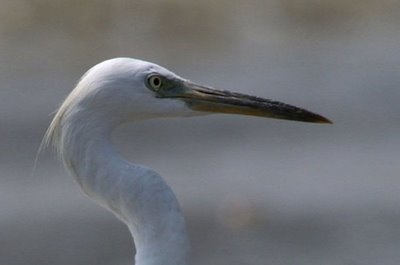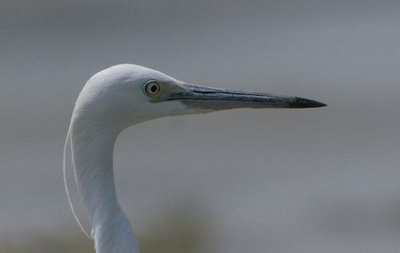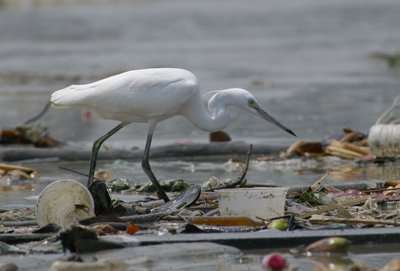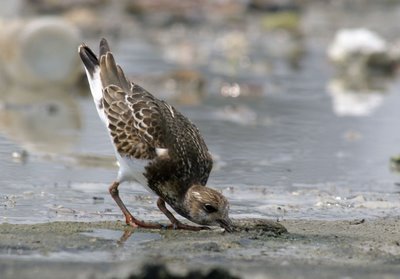No sign of the Little Stint at high tide roost today, but there were a few new arrivals; my first Broad-billed Sandpiper and Common Tern of the autumn, 4 Red Knot (highest count so far), and some juvenile Curlew Sandpipers and Common Sandpipers and Ruddy Turnstones coming through finally. Sand Plover and Pacific Golden Plover numbers were well down on recent weeks.
I realised that I was seeing more or less the same birds in front of my hide (chiefly stints and sand plovers), so decided to move it today to see if it would produce different birds. Results were quite pleasing - fewer birds overall, but the chance to snap some different species at close quarters - Ruddy Turnstone, Common Sandpiper and, best of all, a Chinese Egret feeding on the tideline with Little Egrets, giving me some good photo opportunities!

Beautiful but rare. There are estimated to be fewer than 3,000 of this species left in the world, http://www.rdb.or.id/detailbird.php?id=83, and it is threatened everywhere - on the breeding grounds and at migration and wintering sites - by habitat degradation

An illustration of habitat degradation! Fancy finding food in this muck?

The bird was surprisingly difficult to pick out at a distance; the differences from Little Egret in bare part colour and structure being quite subtle.

Detail of the head.There is a vestigial spray of plumes at the back of the head, typical of Chinese. Little shows only one or two single feather plumes, and Pacific Reef, none at all. The bill is quite hefty compared to Little, with a distinctly curved culmen. It is yellow at the base. The loral skin is pale blue on this bird. It will probably become yellower as the over the winter. The really distinctive thing about the loral skin though is the shape; the way the top edge dips down and up again in a kink just in front of the eye. This distinguishes Chinese from Pacific Reef and Little, in which the top edge of the lores is straight or evenly curved.

For comparison, here's a Little Egret's head. The bill is rather thin and parallel edged. It's mainly black (muddy on this bird!)with a pale flesh or even pale bluish base to the lower mandible. The top edge of the lores is more or less straight. A single plume is visible at the back of this bird's head.

Great Egrets should pose no identification problems, partly due to their size, and partly due to the distinctive dagger-shaped triangle of skin that extends below and behind the eye.

A Little Egret feeding in the tideline trash.

I was pleased to get this picture of my first juvenile Common Sandpiper of the autumn.

You can clearly see the paler parts of the feathers wearing away more quickly than the dark, pigmented areas. The wear is quite advanced on the tertials and greater coverts.

A classic adult non-breeding Red-necked Stint in alert posture.

After seeing the Little Stint, I was interested to see if I could find any Red-necked Stints with breast-bands. This one is typical of the adults that are moulting from breeding to non-breeding plumage. The breast band is on the lower breast only. The upper breast is clean white. Streaking on the rear flanks is a good pointer for Red-necked if present. The streaks disappear as moult to non-breeding plumage progresses.

A juvenile Ruddy Turnstone at close quarters.

Here's the feeding behaviour that gives this bird its name!
I realised that I was seeing more or less the same birds in front of my hide (chiefly stints and sand plovers), so decided to move it today to see if it would produce different birds. Results were quite pleasing - fewer birds overall, but the chance to snap some different species at close quarters - Ruddy Turnstone, Common Sandpiper and, best of all, a Chinese Egret feeding on the tideline with Little Egrets, giving me some good photo opportunities!

Beautiful but rare. There are estimated to be fewer than 3,000 of this species left in the world, http://www.rdb.or.id/detailbird.php?id=83, and it is threatened everywhere - on the breeding grounds and at migration and wintering sites - by habitat degradation

An illustration of habitat degradation! Fancy finding food in this muck?

The bird was surprisingly difficult to pick out at a distance; the differences from Little Egret in bare part colour and structure being quite subtle.

Detail of the head.There is a vestigial spray of plumes at the back of the head, typical of Chinese. Little shows only one or two single feather plumes, and Pacific Reef, none at all. The bill is quite hefty compared to Little, with a distinctly curved culmen. It is yellow at the base. The loral skin is pale blue on this bird. It will probably become yellower as the over the winter. The really distinctive thing about the loral skin though is the shape; the way the top edge dips down and up again in a kink just in front of the eye. This distinguishes Chinese from Pacific Reef and Little, in which the top edge of the lores is straight or evenly curved.

For comparison, here's a Little Egret's head. The bill is rather thin and parallel edged. It's mainly black (muddy on this bird!)with a pale flesh or even pale bluish base to the lower mandible. The top edge of the lores is more or less straight. A single plume is visible at the back of this bird's head.

Great Egrets should pose no identification problems, partly due to their size, and partly due to the distinctive dagger-shaped triangle of skin that extends below and behind the eye.

A Little Egret feeding in the tideline trash.

I was pleased to get this picture of my first juvenile Common Sandpiper of the autumn.

You can clearly see the paler parts of the feathers wearing away more quickly than the dark, pigmented areas. The wear is quite advanced on the tertials and greater coverts.

A classic adult non-breeding Red-necked Stint in alert posture.

After seeing the Little Stint, I was interested to see if I could find any Red-necked Stints with breast-bands. This one is typical of the adults that are moulting from breeding to non-breeding plumage. The breast band is on the lower breast only. The upper breast is clean white. Streaking on the rear flanks is a good pointer for Red-necked if present. The streaks disappear as moult to non-breeding plumage progresses.

A juvenile Ruddy Turnstone at close quarters.

Here's the feeding behaviour that gives this bird its name!
No comments:
Post a Comment